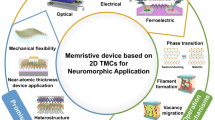Abstract
This study introduces a novel application of machine learning using indium phosphide heterojunction bipolar transistors as an example. The objective is to predict the device performance and optimize the device structure by utilizing an artificial neural network (ANN) to calculate the device direct current (DC) and frequency characteristics. To this end, we develop a physics-inspired ANN that emphasizes the significance of the first-order partial derivative of the current over voltage. The ANN is trained on a data set generated by technology computer-aided design simulations, covering a range of voltage setups, device geometries, and doping concentrations. The resulting model accurately predicts the DC and frequency characteristics of the device, and obtain key performance indicators such as the DC current amplification factor, cut-off frequency, and maximum oscillation frequency. This approach can significantly speed up the device parameter optimization and provide a potential numerical tool for design technology co-optimization.








Similar content being viewed by others
Data availability
Enquiries about data availability should be directed to the authors.
References
Ma, T., Moroz, V., Borges, R., Smith, L.: TCAD: present state and future challenges. In: 2010 International Electron Devices Meeting (IEDM), pp. 15–311534 (2010). https://doi.org/10.1109/IEDM.2010.5703367
Myung, S., Jang, W., Jin, S., Choe, J.M., Jeong, C., Kim, D.S.: Restructuring TCAD system: teaching traditional TCAD new tricks. In: 2021 IEEE International Electron Devices Meeting (IEDM), pp. 18–211824 (2021). https://doi.org/10.1109/IEDM19574.2021.9720616
Ko, K., Lee, J.K., Kang, M., Jeon, J., Shin, H.: Prediction of process variation effect for ultrascaled GAA vertical FET devices using a machine learning approach. IEEE Trans. Electron Devices 66(10), 4474–4477 (2019). https://doi.org/10.1109/TED.2019.2937786
Ko, K., Lee, J.K., Shin, H.: Variability-aware machine learning strategy for 3-D NAND flash memories. IEEE Trans. Electron Devices 67(4), 1575–1580 (2020). https://doi.org/10.1109/TED.2020.2971784
Hirtz, T., Huurman, S., Tian, H., Yang, Y., Ren, T.-L.: Framework for TCAD augmented machine learning on multi-I-V characteristics using convolutional neural network and multiprocessing. J. Semicond. 42(12), 124101 (2021). https://doi.org/10.1088/1674-4926/42/12/124101
Mehta, K., Wong, H.Y.: Prediction of FinFET current–voltage and capacitance–voltage curves using machine learning with autoencoder. IEEE Electron Device Lett. 42(2), 136–139 (2021)
Akbar, C., Li, Y., Sung, W.L.: Machine learning aided device simulation of work function fluctuation for multichannel gate-all-around silicon nanosheet MOSFETs. IEEE Trans. Electron Devices 68(11), 5490–5497 (2021). https://doi.org/10.1109/TED.2021.3084910
Carrillo-Nuñez, H., Dimitrova, N., Asenov, A., Georgiev, V.: Machine learning approach for predicting the effect of statistical variability in Si junctionless nanowire transistors. IEEE Electron Device Lett. 40(9), 1366–1369 (2019). https://doi.org/10.1109/LED.2019.2931839
Wang, J., Kim, Y.-H., Ryu, J., Jeong, C., Choi, W., Kim, D.: Artificial neural network-based compact modeling methodology for advanced transistors. IEEE Trans. Electron Devices 68(3), 1318–1325 (2021). https://doi.org/10.1109/TED.2020.3048918
Han, S.-C., Choi, J., Hong, S.-M.: Acceleration of semiconductor device simulation with approximate solutions predicted by trained neural networks. IEEE Trans. Electron Devices 68(11), 5483–5489 (2021). https://doi.org/10.1109/TED.2021.3075192
Yang, Q., Qi, G., Gan, W., Wu, Z., Yin, H., Chen, T., Hu, G., Wan, J., Yu, S., Lu, Y.: Transistor compact model based on multigradient neural network and its application in spice circuit simulations for gate-all-around Si cold source FETs. IEEE Trans. Electron Devices 68(9), 4181–4188 (2021). https://doi.org/10.1109/TED.2021.3093376
Li, M., İrsoy, O., Cardie, C., Xing, H.G.: Physics-inspired neural networks for efficient device compact modeling. IEEE J. Exploratory Solid-State Comput. Devices Circuits 2, 44–49 (2017). https://doi.org/10.1109/JXCDC.2016.2636161
Karniadakis, G.E., Kevrekidis, I.G., Lu, L., Perdikaris, P., Wang, S., Yang, L.: Physics-informed machine learning. Nat. Rev. Phys. 3(6), 422–440 (2021)
Haykin, S.: Neural Networks and Learning Machines. Prentice Hall, New York (2009)
Ioffe, S., Szegedy, C.: Batch normalization: accelerating deep network training by reducing internal covariate shift. In: Proceedings of the 32nd International Conference on International Conference on Machine Learning (ICML), vol. 37, pp. 448–456 (2015)
Ba, J.L., Kiros, J.R., Hinton, G.E.: Layer normalization. arXiv preprint arXiv:1607.06450 (2016)
He, K., Zhang, X., Ren, S., Sun, J.: Deep residual learning for image recognition. In: 2016 IEEE Conference on Computer Vision and Pattern Recognition (CVPR), pp. 770–778 (2016). https://doi.org/10.1109/CVPR.2016.90
Luo, Z., Shapira, S., Stiles, K.: Correlations of MOSFET transconductance: its physical origins and relevance to analog MOSFET modeling and operation. IEEE Trans. Electron Devices 50(3), 853–858 (2003). https://doi.org/10.1109/TED.2003.811391
Yuan, Z., Yu, Z.: Short-channel-effect modeling of DG-FETs using voltage-doping transformation featuring FD/PD modes. IEEE Electron Device Lett. 30(11), 1209–1211 (2009). https://doi.org/10.1109/LED.2009.2031503
Zhang, L., Chan, M.: Artificial neural network design for compact modeling of generic transistors. J. Comput. Electron. 16, 825–832 (2017)
Zhang, Z.: Improved adam optimizer for deep neural networks. In: 2018 IEEE/ACM 26th International Symposium on Quality of Service (IWQoS), pp. 1–2 (2018). https://doi.org/10.1109/IWQoS.2018.8624183
Funding
This work is financially supported by the National Natural Science Foundation of China (NSFC, Grant Nos.11974268 and 12111530061).
Author information
Authors and Affiliations
Contributions
All authors participated in the conception and design of this study. JW conducted TCAD simulation and data preparation. All authors contributed to the building of the machine learning model and analysis of the results. XJ, JW, and DW initially drafted the manuscript, and all authors provided feedback on earlier versions. The final manuscript was reviewed and approved by all authors.
Corresponding authors
Ethics declarations
Conflict of interest
The authors have no relevant financial or non-financial interests to disclose.
Additional information
Publisher's Note
Springer Nature remains neutral with regard to jurisdictional claims in published maps and institutional affiliations.
Rights and permissions
Springer Nature or its licensor (e.g. a society or other partner) holds exclusive rights to this article under a publishing agreement with the author(s) or other rightsholder(s); author self-archiving of the accepted manuscript version of this article is solely governed by the terms of such publishing agreement and applicable law.
About this article
Cite this article
Jie, X., Wang, J., Ouyang, X. et al. Characteristics prediction and optimization of InP HBT using machine learning. J Comput Electron (2024). https://doi.org/10.1007/s10825-024-02139-8
Received:
Accepted:
Published:
DOI: https://doi.org/10.1007/s10825-024-02139-8




